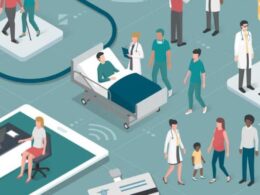Kings Fund
30 May 2018
ehrintellligence
On Friday, two major changes to the way the NHS handles patient data came into force: the national data opt-out and the General Data Protection Regulation.
Our latest briefing details how these changes bolster safeguards for patient data, as well as flagging some of the potential implications of the changes.
There are many ways that patient data is saving the NHS and here we explore five. For more examples Understanding Patient Data has a bank of case studies.
- Identifying unwarranted variation in preventable amputations
- Redefining clinical trials using real-world patient data
- Unravelling myths about the MMR vaccine and autism
- Understanding how to screen newborn babies for severe visual impairments
- Linking data to provide more integrated care for patients
Identifying unwarranted variation in preventable amputations
Diabetes is one of the leading causes of amputation of the lower limbs in the NHS. Four in five diabetes-related amputations in England are preventable if patients and health professionals get the right support early enough to recognise deterioration. Diabetes UK needed more information about patients to help them decide where to target their resources to make the most impact.
NHS Digital provided Diabetes UK with data from the National Diabetes Audit, which links hospital and primary care data to create a detailed picture of patients with diabetes. Patient data was depersonalised before being shared.
Diabetes UK used the data to inform their Putting Feet First campaign, which empowers patients and health professionals to see the symptoms that can lead to an amputation.
They also used this linked data to encourage commissioners and providers to develop a more integrated pathway for foot care to reduce the regional variation in care that the analysis uncovered.
Redefining clinical trials using real-world patient data
Traditional clinical trials have drawbacks in how they select patients, for example, often excluding patients with other multiple conditions.
The Salford Lung Study was designed to include those patients who would often be excluded, using data collected on them in different settings — eg, from GPs, pharmacists and hospitals — to understand the effectiveness of a new treatment for chronic obstructive pulmonary disorder.
Patients consented to be in the trial and their data was linked and monitored for a year. This unique approach allowed for a bigger, near-real time study of patients, without the intrusion of a traditional trial, which benefited patients. The study has shown that patients benefit from this new treatment compared to usual practice.
Unravelling myths about the MMR vaccine and autism
Research that appeared to demonstrate a link between the measles, mumps and rubella (MMR) vaccine and autism led to fewer parents getting their children vaccinated.
Researchers began a new study to look at the impact of MMR on autism diagnosis. The researchers used depersonalised data from the Clinical Practice Research Datalink to understand how vaccination rates among children diagnosed with autism differed from those among children who did not have autism.
The study clearly demonstrated that there is no link between the MMR vaccine and autism, rebuilding public trust in vaccination.
Understanding how to screen newborn babies for severe visual impairments
Little is known about which babies are likely to be born with severe visual impairments or how problems can be identified sooner. Researchers collected information from a variety of sources about children with vision problems and how they were being treated.
Although information that could easily identify individual children was removed, it could not be considered completely anonymous as researchers needed to link information being provided by different doctors on the same patient. Specific approvals and safeguards were followed, and where consent was not possible, Section 251 of the NHS Act 2006 was used to get access to identifiable patient information. All patients could opt out of the research.
The study provided invaluable information that allows health organisations to plan better for where screening babies for visual impairments will be most needed.
Linking data to provide more integrated care for patients
The aim of the Symphony programme in Somerset is for GPs, hospitals, community services and social care to provide a more integrated service for their local population.
Symphony commissioned South Central West Commissioning Support Unit to collate patient information from across the area into a single anonymised patient record that would allow them to analyse patients’ use of services.
Linking data from different care settings necessitated the use of identifiable data from patients, for which various safeguards were put in place, including a rigorous approval process.
After linking, the dataset was depersonalised and used by Symphony to identify which groups would benefit most from integration and to understand costs for patients across different care settings.
Specifically, analysis showed that costs of care are driven by morbidity more than by age, providing a more solid foundation for patient-centred care.
Linking data from different care settings necessitated the use of identifiable data from patients, for which various safeguards were put in place, including a rigorous approval process.

An important week for patient data
The Twitter hashtag #datasaveslives is filled with examples of how researchers and the NHS use patient data to improve health and care.
Our new briefing highlights that important though it is to keep information about patients safe and secure, we believe that we also need to recognise the contribution that data makes to the health of the population.
Originally published at https://www.kingsfund.org.uk on May 30, 2018.
TAGS: Data Driven Health Care; Use Cases; Patient Data Sharing; Interoperability












